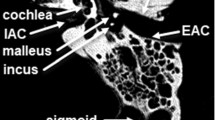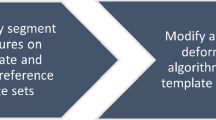Abstract
Purpose
To develop a time-efficient automated segmentation approach that could identify critical structures in the temporal bone for visual enhancement and use in surgical simulation software.
Methods
An atlas-based segmentation approach was developed to segment the cochlea, ossicles, semicircular canals (SCCs), and facial nerve in normal temporal bone CT images. This approach was tested in images of 26 cadaver bones (13 left, 13 right). The results of the automated segmentation were compared to manual segmentation visually and using DICE metric, average Hausdorff distance, and volume similarity.
Results
The DICE metrics were greater than 0.8 for the cochlea, malleus, incus, and the SCCs combined. It was slightly lower for the facial nerve. The average Hausdorff distance was less than one voxel for all structures, and the volume similarity was 0.86 or greater for all structures except the stapes.
Conclusions
The atlas-based approach with rigid body registration of the otic capsule was successful in segmenting critical structures of temporal bone anatomy for use in surgical simulation software.






Similar content being viewed by others
References
Klein S, Staring M, Murphy K, Viergever MA, Pluim JPW (2010) Elastix: a toolbox for intensity based medical image registration. IEEE Trans Med Imaging 29:196–205
Shamonin DP, Bron EE, Lelieveldt BPF, Smits M, Klein S, Staring M (2014) Fast parallel image registration on CPU and GPU for diagnostic classification of Alzheimer’s disease. Front Neuroinform 7:1–15
Klein S, Staring M (2014) Elastix the manual. http://elastix.isi.uu.nl/
Otsu N (1979) A threshold selection method from gray-level histogram. IEEE Trans Syst Man Cybern SMC 9:62–66
Gonzalez RC, Woods RE (2008) Digital image processing. Pearson Prentice Hall Inc., Upper Saddle River
Taha AA, Hanbury A (2015) Metrics for evaluating 3D medical image segmentation: analysis, selection, and tool. BMC Med Imaging 15(29):1–28
Zijdenbos AP, Dawant BM, Margolin RA, Palmer A (1994) Morphometrics analysis of white matter lesions in MR images: method and validation. IEEE Trans Med Imaging 13(4):716–724
Noble JH, Labadie RF, Majdani O, Dawant BM (2010) Automatic segmentation of intra-cochlear anatomy in conventional CT. IEEE Trans Biomed Eng 58(9):2625–2632
Noble JH, Warren FM, Labadie RF, Dawant BM (2008) Automatic segmentation of the facial nerve and chorda tympani in CT images using spatially dependent feature analysis. Med Phys 35:5375–5384
Noble JH, Dawant BM, Warren FM, Labadie RF (2009) Automatic identification and 3D rendering of temporal bone anatomy. Otol Neurotol 30:346–442
Rodt T, Raiu P, Becker H, Bartling S, Kacher DF, Anderson M, Jolesz FA, Kikinis R (2002) 3D visualisation of the middle ear and adjacent structures using reconstructed multi-slice CT datasets, correlating 3D images and virtual endoscopy to the 2D cross-sectional images. Neuroradiology 44:783–790
Seemann MD, Seemann O, Bonel H, Suckfull M, Englmeier K-H, Naumann A, Allen CM, Reiser MF (1999) Evaluation of the middle and inner ear structures: comparison of hybrid rendering, virtual endoscopy and axial 2D source images. Eur Radiol 9:1851–1858
Chan S, Li P, Locketz G, Salisbury K, Blevins NH (2016) High fidelity haptic and visual rendering for patient-specific simulation of temporal bone surgery. Comput Assist Surg 21:85–101
Hassan K, Dort JC, Sutherland GR, Chan S (2016) Evaluation of software tools for segmentation of temporal bone anatomy. Proc Med Meets Virtual Real 22:130–133
Arora A, Swords C, Khemani S, Awad Z, Darzi A, Singh A, Tolley N (2014) Virtual reality case-specific rehearsal in temporal bone surgery: a preliminary evaluation. Int J Surg 12:141–145
Lee DH, Chan S, Salisbury C, Kim N, Salisbury K, Puria S, Blevins NH (2010) Reconstruction and exploration of virtual middle-ear models derived from micro-CT datasets. Hear Res 263:198–203
Rafferty MA, Siewerdsen JH, Chan Y, Daly MJ, Moseley DJ, Jaffray DA, Irish JC (2006) Intraoperative cone-beam CT for guidance of temporal bone surgery. Otolaryngol Head Neck Surg 134:801–808
Barker E, Trimble K, Chan H, Ramsden J, Nithiananthan S, James A, Bachar G, Daly M, Irish J, Siewerdsen J (2009) Intraoperative use of cone-beam computed tomography in a cadaveric ossified cochlea model. Otolaryngol Head Neck Surg 140:697–702
Erovic BM, Chan HHL, Daly MJ, Pothier DD, Yu E, Coulson C, Lai P, Irish JC (2014) Intraoperative cone-beam computed tomography and multi-slice computed tomography in temporal bone imaging for surgical treatment. Otol Neurotol 150:107–114
Uneri A, Schafer S, Mirota DJ, Nithiananthan S, Otake Y, Taylor RH, Siewerdsen JH (2012) TREK: and integrated system architecture for intraoperative cone-beam CT-guided surgery. Int J CARS 7:159–173
Acknowledgements
This research was supported by NIDCD/NIH 1R01-DC011321.
Author information
Authors and Affiliations
Corresponding author
Ethics declarations
Conflict of interest
The authors declare that they have no conflict of interest.
Ethical approval
All procedures performed in studies involving human participants were in accordance with the ethical standards of the institutional and/or national research committee and with the 1964 Helsinki Declaration and its later amendments or comparable ethical standards.
Informed consent
For this type of study, formal consent is not required.
Rights and permissions
About this article
Cite this article
Powell, K.A., Liang, T., Hittle, B. et al. Atlas-Based Segmentation of Temporal Bone Anatomy. Int J CARS 12, 1937–1944 (2017). https://doi.org/10.1007/s11548-017-1658-6
Received:
Accepted:
Published:
Issue Date:
DOI: https://doi.org/10.1007/s11548-017-1658-6




